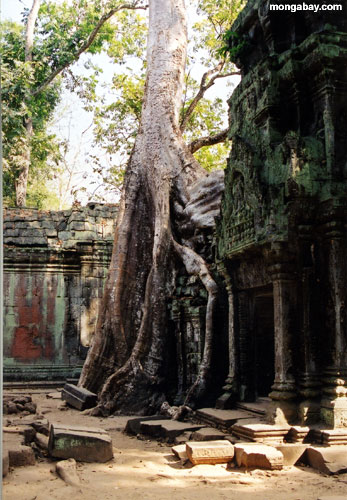Cultural heritage sites could play a key role in efforts to alleviate poverty provided they are protected from a growing range of threats, says a new report published by the Global Heritage Fund (GHF).
The report, Saving Our Vanishing Heritage: Safeguarding Endangered Cultural Heritage Sites in the Developing World, assesses 500 major archaeological and heritage sites in developing countries and finds that nearly 200 are “at risk”, “under threat”, or “on the verge” from development pressures, unsustainable tourism, insufficient management, looting, and/or war and conflict.
It estimates that safeguarding these sites could generate $100 billion per year by 2025 in developing countries. Revenues from the sites already amount to $24.7 billion annually, but more money needs to reach local people in and around these places in order to help eradicate poverty and create long-term incentives for preservation and restoration.
 Ta Prohm in Angkor Wat, Cambodia. Photo by: Rhett A. Butler. |
The report notes that heritage sites in the developing world suffer from lack of recognition from international institutions, making it more difficult for them to attract needed investment. For example, the report says Italy has 44 cultural UNESCO World Heritage designations, while Guatemala, the cradle of Maya civilization, has just three.
“The world of heritage preservation must move from older government-to-government models that are often slowed by bureaucracy, corruption and dependence to one that is dynamic, grounded in local partnerships, supported by government and private donors, and is consistently focused on long-term sustainability,” said Jeff Morgan, executive director of GHF. “To save our vanishing global heritage, we must immediately address the lack of attention and anemic funding levels that these irreplaceable treasures of humanity receive, especially those facing rapid changes in tourism growth or modern development.
“Heritage sites face a tipping point: either degradation or conservation,” he told the audience attending the Global Heritage Fund Forum at Stanford University on October 19. “The conservation path drives benefits that accrue over time.”
“Overuse without reinvestment and equal investments in management equals disaster.”
To better protect heritage sites, GHF has launched an early warning and threats monitoring system – Global Heritage Network (GHN) – that uses satellite imaging technology and ground reporting to enable observers to “identify and solve imminent threats within the legal core and protected areas of each site.”
“I don’t understand how we as a planet can’t save 500 1-mile by 1-mile spots around the world,” said Morgan. “It’s not saving the Amazon or sending someone to the moon.”
Related articles